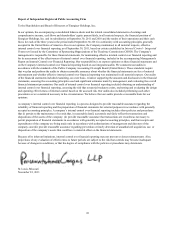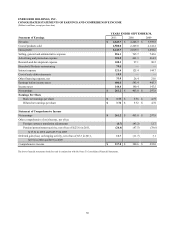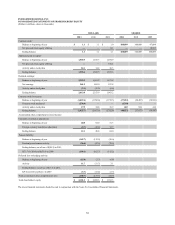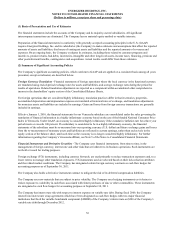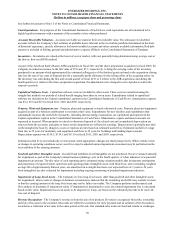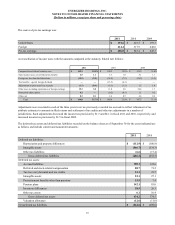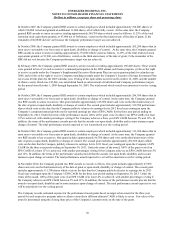Energizer 2011 Annual Report Download - page 65
Download and view the complete annual report
Please find page 65 of the 2011 Energizer annual report below. You can navigate through the pages in the report by either clicking on the pages listed below, or by using the keyword search tool below to find specific information within the annual report.
ENERGIZER HOLDINGS, INC.
NOTES TO CONSOLIDATED FINANCIAL STATEMENTS
(Dollars in millions, except per share and percentage data)
See further discussion in Note 15 of the Notes to Consolidated Financial Statements.
Cash Equivalents - For purposes of the Consolidated Statements of Cash Flows, cash equivalents are all considered to be
highly liquid investments with a maturity of three months or less when purchased.
Accounts Receivable Valuation – Accounts receivable are stated at their net realizable value. The allowance for doubtful
accounts reflects the Company’s best estimate of probable losses inherent in the receivables portfolio determined on the basis
of historical experience, specific allowances for known troubled accounts and other currently available information. Bad debt
expense is included in Selling, general and administrative expense (SG&A) in the Consolidated Statements of Earnings.
Inventories - Inventories are valued at the lower of cost or market, with cost generally being determined using average cost or
the first-in, first-out (FIFO) method.
As part of the American Safety Razor (ASR) acquisition in fiscal 2011 and the shave preparation acquisition in fiscal 2009, the
Company recorded an increase in the fair value of $7.0 and $3.7, respectively, to bring the carrying value of the inventory
purchased to an amount which approximated the estimated selling price of the finished goods on hand at the acquisition closing
date less the sum of (a) costs of disposal and (b) a reasonable profit allowance for the selling effort of the acquiring entity. As
the inventory was sold during the first and second quarter of fiscal 2011 as it relates to the ASR acquisition, and during the
fourth quarter as it relates to the shave preparation acquisition, the adjustments were charged to cost of products sold in the
respective periods.
Capitalized Software Costs - Capitalized software costs are included in other assets. These costs are amortized using the
straight-line method over periods of related benefit ranging from three to seven years. Expenditures related to capitalized
software are included in the Capital expenditures caption in the Consolidated Statements of Cash Flows. Amortization expense
was $5.2, $5.8 and $5.9 in fiscal 2011, 2010 and 2009, respectively.
Property, Plant and Equipment, net – Property, plant and equipment is stated at historical costs. Property, plant and equipment
acquired as part of a business combination is recorded at fair value. Expenditures for new facilities and expenditures that
substantially increase the useful life of property, including interest during construction, are capitalized and reported in the
Capital expenditures caption in the Consolidated Statements of Cash Flows. Maintenance, repairs and minor renewals are
expensed as incurred. When property is retired or otherwise disposed of, the related cost and accumulated depreciation are
removed from the accounts, and gains or losses on the disposition are reflected in earnings. Depreciation is generally provided
on the straight-line basis by charges to costs or expenses at rates based on estimated useful lives. Estimated useful lives range
from two to 25 years for machinery and equipment and three to 30 years for buildings and building improvements.
Depreciation expense was $154.5, $119.3 and $111.0 in fiscal 2011, 2010 and 2009, respectively.
Estimated useful lives are periodically reviewed and, when appropriate, changes are made prospectively. When certain events
or changes in operating conditions occur, asset lives may be adjusted and an impairment assessment may be performed on the
recoverability of the carrying amounts.
Goodwill and Other Intangible Assets - Goodwill and indefinite-lived intangibles are not amortized, but are evaluated annually
for impairment as part of the Company's annual business planning cycle in the fourth quarter, or when indicators of a potential
impairment are present. The fair value of each reporting unit is estimated using valuation models that incorporate assumptions
and projections of expected future cash flows and operating plans. Intangible assets with finite lives, and a remaining weighted
average life of approximately thirteen years, are amortized on a straight-line basis over expected lives of 3 years to 20 years.
Such intangibles are also evaluated for impairment including ongoing monitoring of potential impairment indicators.
Impairment of Long-Lived Assets – The Company reviews long-lived assets, other than goodwill and other intangible assets
for impairment, when events or changes in business circumstances indicate that the remaining useful life may warrant revision
or that the carrying amount of the long-lived asset may not be fully recoverable. The Company performs undiscounted cash
flow analysis to determine if impairment exists. If impairment is determined to exist, any related impairment loss is calculated
based on fair value. Impairment losses on assets to be disposed of, if any, are based on the estimated proceeds to be received,
less cost of disposal.
Revenue Recognition - The Company's revenue is from the sale of its products. Revenue is recognized when title, ownership
and risk of loss pass to the customer. Discounts are offered to customers for early payment and an estimate of the discounts is
recorded as a reduction of net sales in the same period as the sale. Our standard sales terms are final and returns or exchanges
55






